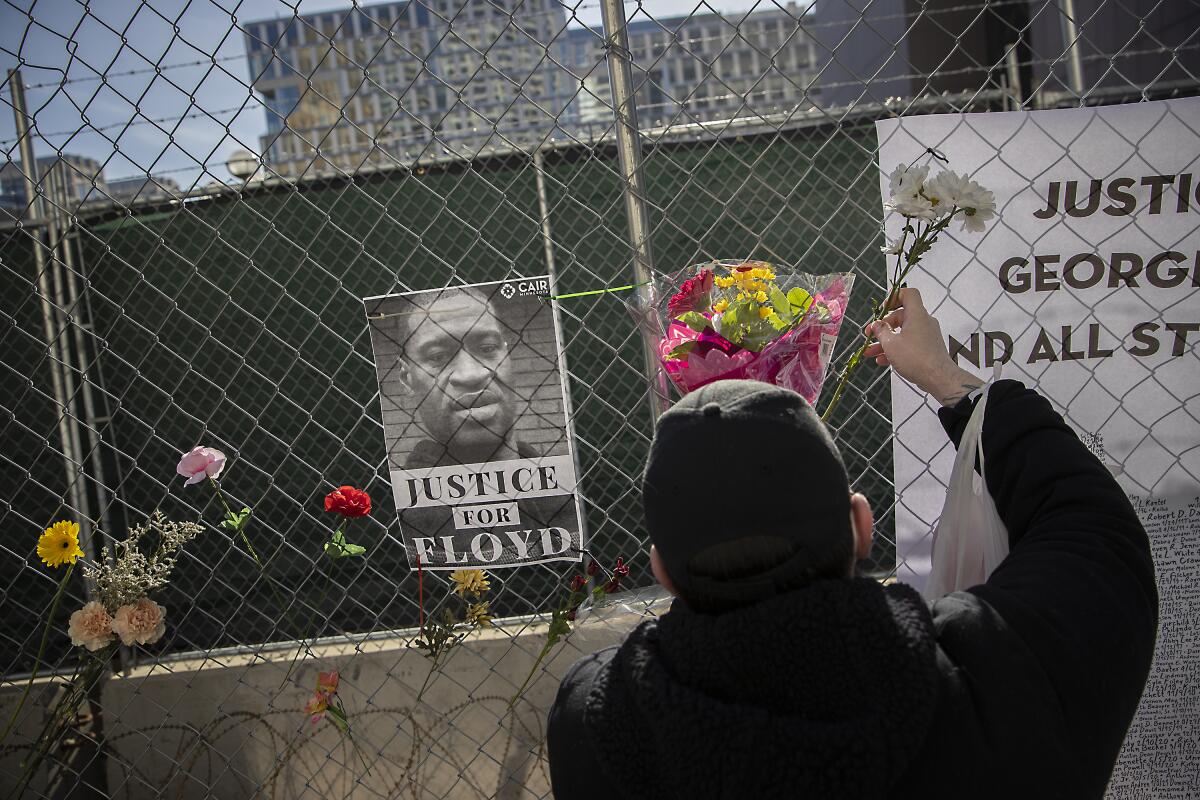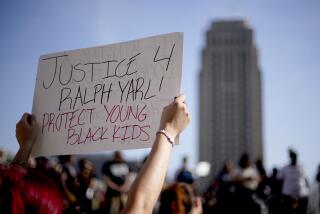Column: Derek Chauvin’s race-baiting defense is rooted in centuries-old stereotypes

I’ve been seething inside this week as I watched the trial of former Minneapolis police officer Derek Chauvin, charged with murder in the death of George Floyd, a Black man he was trying to arrest for using a fake $20 bill to buy cigarettes.
I don’t know what I expected — but it wasn’t that the defense for a racist killing would itself be rooted in racism.
The Chauvin team is doubling down on the hope that race-based fear-mongering can convince at least one juror that the officer was outmatched by a big, scary Black demon.
That’s not what we saw when the video of his encounter with Floyd surfaced last spring.
The nine-minute video of Floyd dying — handcuffed and face down in the street, with Chauvin kneeling on his neck — sparked weeks of protests across the country and around the world. It brought police brutality and structural racism into focus for people who’d never felt the need to pay attention before.
The commitment of the protesters and diversity of the crowds back then was heartening to see. It allowed me to believe we were in the midst of an important social shift, a move toward a real philosophy of Black lives mattering.
Now that perception is being tested in the Minneapolis courtroom, in a trial that cannot separate itself from the dynamics of race and policing in America.
And already the race-baiting tactics have begun.
In the first days of the trial this week, prosecution eyewitnesses were interrogated by defense attorney Eric Nelson about the current of anger rippling through the small group of people watching from the sidewalk as Chauvin kept Floyd pinned to the ground.
“It’s fair to say you grew angrier and angrier?” Nelson asked Donald Williams, a Black man who had incessantly implored the officer to let Floyd breathe.
Williams, a security guard and mixed martial arts fighter, knew not to take the bait. “I grew professional and professional. I stayed in my body,” Williams replied. “You can’t paint me out to be angry.”
It’s not as if anger is an inappropriate emotion when you’re watching a police officer casually allow a man to die in his custody. Anger is what drove protesters to the streets. But Black men are not allowed to be angry without also being deemed threatening.
Chauvin’s lawyer understands that. So, in an effort to blunt the impact of the damning video, Nelson is turning the camera on the crowd at the scene, insinuating they were frighteningly unruly and prone to violence.
In reality, there were only about a dozen folks gathered on the sidewalk — separated from Chauvin and Floyd by armed police officers. Some in the crowd cried and yelled and pleaded with Chauvin to let Floyd live. And some berated the officer for what they knew was unnecessary cruelty.
In Nelson’s telling, those onlookers were the villains and Chauvin the victim. Their outrage made the policeman feel threatened and distracted him from properly tending to the man beneath his knee. The defense narrative aims to shift the responsibility for Floyd’s death from Chauvin to a band of scary Black people intent on disrupting police.
That blame-shifting perspective is baked into the standard strategy for defending cops on trial: humanize the officers, dehumanize the victims ... and people who look like them, if need be.
It’s a tactic rooted in centuries-old stereotypes that portray Black men as inherently dangerous. Still, it’s a go-to for desperate defense lawyers for an important reason: it’s been eminently successful in keeping abusive police officers out of prison.
We lived that experience here in Los Angeles almost 30 years ago, when the whole world saw video of Rodney King being beaten to a pulp by a mob of officers — but the jury acquitted the cops, buying their claim that King’s “superhuman strength” justified every blow he received.
The strategy of demonizing the victim works particularly well when the victim is Black, because it activates the unconscious racial biases jurors unwittingly bring into the courtroom. Research has shown that people of every race tend to overestimate the size, weight and strength of Black men, and perceive Black bodies as more threatening than white bodies.
In a series of studies in 2017, people who were asked to estimate the height, weight and strength of young men based solely on photos of their faces consistently rated Black men bigger and stronger than white men of similar size. And when asked to evaluate racially ambiguous pictures of men’s bodies, people rated the body stronger and more formidable when they were told the subject was Black.
In that same series of studies, white participants rated Black men more capable of doing harm than white men of the same physical stature and size. And they also believed that police would be justified in using more force to subdue Black men.
The perception of danger attached to Black men starts early and weaves itself into our thinking over time. Even sixth-graders shown drawings of one kid pushing another, and then asked if they were fighting or playing, considered the white kids pictured friendlier and the Black children more threatening.
These kinds of deep-rooted stereotypes are painful to acknowledge and difficult to dislodge. But recognizing and rejecting that kind of biased thinking is necessary in order for Black lives to really matter in this country.
There is more at stake in the courtroom now than Derek Chauvin’s guilt or innocence and George Floyd’s legacy.
There’s the question of what jurors in the murder trial will ultimately see: a failure of tactics by a beleaguered police officer trying to manage a gargantuan threat — or a lapse of humanity by a callous cop unmoved by the pleas of a dying man struggling to breathe.
More to Read
Start your day right
Sign up for Essential California for news, features and recommendations from the L.A. Times and beyond in your inbox six days a week.
You may occasionally receive promotional content from the Los Angeles Times.







